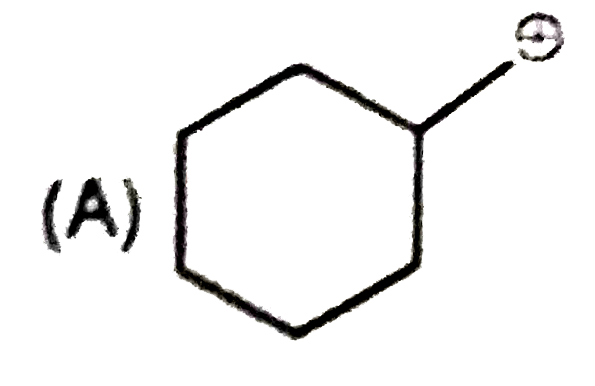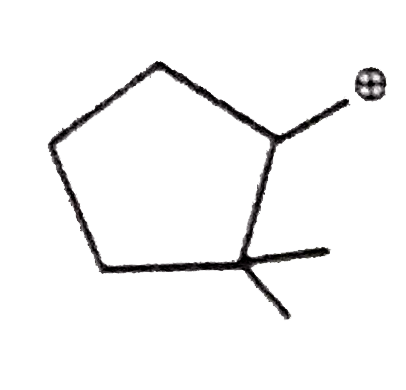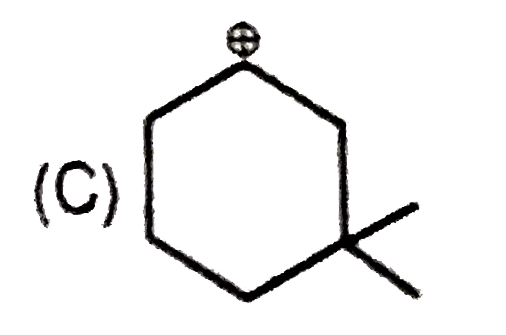Whenever an intermediate carbocation is formed in reaction it may rearranges.
Only those carbocation will rearrange which can produce more stable species . It can be done either by :
(i) Shifting of H, alkyl , aryl, bond (1,2-shifting )
(ii) Ring expansion
(iii) Ring contraction
In which of the following carbocation rearrangement will not take place ?




The correct Answer is:B
Topper's Solved these Questions
- GENERAL ORGANIC CHEMISTRY IIBook:RESONANCEChapter:GENERAL ORGANIC CHEMISTRY IIExercise:Part-III: Section-5: Matching List Type
Explore 1 Video
- GENERAL ORGANIC CHEMISTRY IIBook:RESONANCEChapter:GENERAL ORGANIC CHEMISTRY IIExercise:Part-III: Practice Test-2 (IIT-JEE (Advanced Pattern))
Explore 16 Videos
- GASEOUS STATEBook:RESONANCEChapter:GASEOUS STATEExercise:PHYSICAL CHMISTRY (Gaseous State)
Explore 47 Videos
- GENERAL ORGANIC CHEMISTRY-IBook:RESONANCEChapter:GENERAL ORGANIC CHEMISTRY-IExercise:PART-III : PRACTICE TEST-19
Explore 1 Video
Similar Questions
Whenever an intermediate carbocation is formed in reaction it may rearranges.
Only those carbocation will rearrange which can produce more stable species . It can be done either by :
(i) Shifting of H, alkyl , aryl, bond (1,2-shifting )
(ii) Ring expansion
(iii) Ring contraction
Most stable rearranged carbocation is is
is
View SolutionWhich of the following in the rearranged in the rearranged more stable carbocation of the given species?

View Solution
Knowledge Check
Whenever an intermediate carbocation is formed in reaction it may rearranges.
Only those carbocation will rearrange which can produce more stable species . It can be done either by :
(i) Shifting of H, alkyl , aryl, bond (1,2-shifting )
(ii) Ring expansion
(iii) Ring contraction
Most stable rearranged carbocation is is A
is A B
B C
C D
D
Which of the following is the rearranged more stable carbocation of the given species?
 A
A B
B C
C D
D
Under common reaction conditions, a carbocation rearranges to another carbocation of equal or greater stability. For example, a secondary carbocation will rearrange to a tertiary carbocation. It will not rearrange to a less stable primary carbocation. This generalization is not absolute, and because there is not a high energy barrier to the rearrangement of carbocations, rearrangement to a less stable cation can occur if it offers the chance to form a more stable product.
In which of the following cations rearrangement takes place?A B
B C
C D
D
Under common reaction conditions, a carbocation rearranges to another carbocation of equal or greater stability. For example, a secondary carbocation will rearrange to a tertiary carbocation. It will not rearrange to a less stable primary carbocation. This generalization is not absolute, and because there is not a high energy barrier to the rearrangement of carbocations, rearrangement to a less stable cation can occur if it offers the chance to form a more stable product.
In which of the following cations rearrangement takes place most rapidly?
View SolutionIn which of the following cations rearrangement takes place?
View SolutionUnder common reaction conditions, a carboncation rearranges to another carbocation of equal or greater stability. For example secondary carbocation will rearrange to a tertiary carbocation. It will not rearrange to a less stable primary carbocation. This generalization is not absolute, and because there is not is a high energy barrier to the rearrangement of carbocations, rearrangement to a less stable cation can occur if it offers the chance to forme a more stable product.
In which of the following cations rearrangement takes place most rapidly?
View SolutionWhich of the following in the rearranged in the rearranged more stable carbocation of the given species?

View SolutionUnder common reaction conditions, a carboncation rearranges to another carbocation of equal or greater stability. For example secondary carbocation will rearrange to a tertiary carbocation. It will not rearrange to a less stable primary carbocation. This generalization is not absolute, and because there is not is a high energy barrier to the rearrangement of carbocations, rearrangement to a less stable cation can occur if it offers the chance to forme a more stable product.
In the following cation , H/CH3 that is most likely to migarte to the positively charged carbon is :
H3C1−2H∣C∣OH−3⊕C∣H−4H∣C∣CH3−5CH3
View Solution

